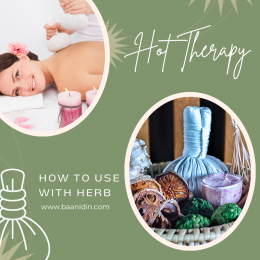Hot therapy benefits how to use with herb
272 Views |

Hot therapy benefits how to use with herb
Hot therapy, also known as thermotherapy, involves using heat to relieve pain and improve health. Like cold therapy, it can be enhanced by incorporating herbs known for their therapeutic properties. The heat can help the body absorb the herbal constituents more effectively, which may amplify the benefits.
Benefits of Hot Therapy:
Muscle Relaxation: Heat helps to relax and loosen tissues, and to increase flexibility.
Pain Relief: It can reduce the sensation of pain by acting on peripheral pain receptors.
Improved Circulation: Heat therapy increases blood flow, which helps to supply oxygen and nutrients to reduce pain and inflammation in the tissues.
Reduction of Joint Stiffness: Heat can reduce stiffness in joints, which can be beneficial in conditions like arthritis.
Healing Enhancement: By improving circulation, heat can help damaged tissues to heal more quickly.
Stress Reduction: The application of heat is generally soothing, which can help to reduce stress and promote relaxation.
How to Use Hot Therapy with Herbs:
Herbal Heat Packs: Fill a fabric pouch with dried herbs such as lavender, chamomile, or rosemary, and a heat-retaining material like rice, flaxseed, or wheat. Microwave or heat in the oven before use.
Warm Herbal Compresses: Soak towels in a warm herbal decoction (a concentrated tea made by boiling herbs in water) and apply them to the affected area. The warmth will help the skin to absorb the herbal constituents.
Herbal Baths: Add herbal extracts, essential oils, or a muslin bag of herbs into a hot bath. The heat from the water helps the skin absorb the herbs, and inhaling the steam can also provide respiratory benefits.
Herbal Oils and Salves: Infuse oils with heat-friendly herbs like ginger or capsicum for their warming and pain-relieving properties. These can be massaged into sore muscles and joints.
Herbal Pads or Pillows: Similar to heat packs, these are pads or pillows that can be heated and are filled with herbs. They are particularly useful for neck or back tension.
Safety and Best Practices:
Temperature: Be cautious not to use heat that is too intense, as it can burn the skin. Aim for a warm temperature that the skin can comfortably tolerate.
Duration: Apply heat for 15-20 minutes at a time, depending on the heat source and the area being treated.
Protection: Use layers between the heat source and the skin, such as fabric or towels, to prevent burns.
Hydration: Ensure you're well-hydrated when using heat therapy, as it can cause the body to sweat and lose fluids.
Skin Check: Regularly check the skin for any signs of irritation or burns, especially if you have neuropathy or reduced skin sensitivity.
Contraindications: Avoid heat therapy on areas where there's bruising, swelling, or acute inflammation, and on areas with poor circulation. Also, people with certain conditions like deep vein thrombosis, dermatitis, vascular diseases, and heart conditions should avoid heat therapy or consult a doctor beforehand.
Herb Choice: Choose herbs that are known for their soothing heat properties and make sure you're not allergic or sensitive to them.
Incorporating herbs into hot therapy can significantly enhance the relaxation and healing effects. However, it's essential to select appropriate herbs and to use the right temperature to avoid any adverse reactions.




